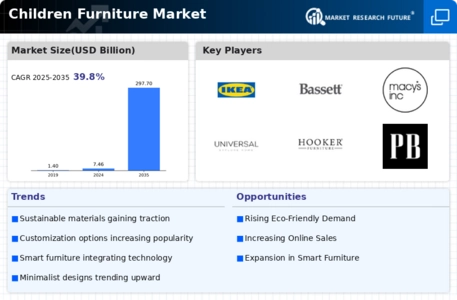Rising Disposable Income
The increasing disposable income among families appears to be a pivotal driver for the Children Furniture Market. As parents experience enhanced financial stability, they are more inclined to invest in high-quality, aesthetically pleasing furniture for their children. This trend is particularly evident in emerging economies, where the middle class is expanding. According to recent data, households with higher disposable income are likely to spend approximately 20% more on children's furniture compared to lower-income households. This shift not only reflects a growing emphasis on children's comfort and style but also indicates a broader trend towards premium products in the Children Furniture Market. Consequently, manufacturers are responding by offering a wider range of innovative and luxurious options, catering to the evolving preferences of consumers.
Increased Focus on Child Development
There is a growing awareness among parents regarding the importance of child development, which significantly influences the Children Furniture Market. Research suggests that well-designed furniture can enhance a child's cognitive and physical development. As a result, parents are increasingly seeking furniture that promotes creativity, learning, and comfort. This trend is reflected in the rising demand for multifunctional furniture that can adapt to a child's changing needs. For instance, desks that can be adjusted for height or beds that incorporate storage solutions are becoming more popular. The Children Furniture Market is thus witnessing a shift towards products that not only serve practical purposes but also contribute to a child's overall growth and well-being. This focus on development is likely to drive innovation and diversification within the market.
Sustainability and Eco-Friendly Materials
The Children Furniture Market is experiencing a notable shift towards sustainability, as consumers become more environmentally conscious. Parents are increasingly prioritizing eco-friendly materials and sustainable production practices when selecting furniture for their children. This trend is driven by a growing awareness of the environmental impact of traditional furniture manufacturing processes. Data indicates that approximately 60% of parents are willing to pay a premium for furniture made from sustainable materials. Consequently, manufacturers are responding by incorporating recycled materials and non-toxic finishes into their products. This commitment to sustainability not only appeals to environmentally conscious consumers but also positions brands favorably in a competitive market. As the demand for eco-friendly options continues to rise, the Children Furniture Market is likely to see an influx of innovative designs that align with these values.
Growing Urbanization and Space Constraints
Urbanization is a significant factor influencing the Children Furniture Market, particularly in densely populated areas where space is at a premium. As families move into smaller living spaces, there is an increasing demand for space-saving furniture solutions. This trend has led to the rise of multifunctional furniture that can serve multiple purposes, such as beds with built-in storage or desks that can be folded away when not in use. Market data suggests that approximately 40% of urban families are actively seeking compact furniture options that maximize utility without compromising on style. Consequently, manufacturers are adapting their offerings to meet this demand, leading to a surge in innovative designs that cater to the needs of urban dwellers. This focus on space-efficient solutions is likely to continue shaping the Children Furniture Market in the coming years.
Technological Advancements in Furniture Design
Technological advancements are playing a crucial role in shaping the Children Furniture Market. Innovations such as 3D printing and smart furniture are revolutionizing how furniture is designed and manufactured. These technologies enable manufacturers to create customized solutions that cater to the unique needs of children. For instance, smart furniture equipped with sensors can monitor a child's posture and provide feedback, promoting healthier habits. Additionally, 3D printing allows for rapid prototyping, enabling designers to experiment with new concepts and materials. This integration of technology not only enhances the functionality of children's furniture but also appeals to tech-savvy parents. As these advancements continue to evolve, the Children Furniture Market is likely to witness a surge in demand for innovative, tech-driven products that enhance the overall user experience.


















Leave a Comment